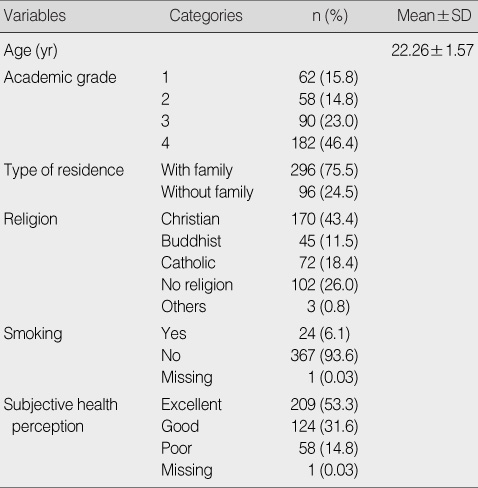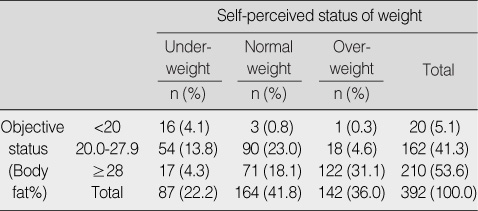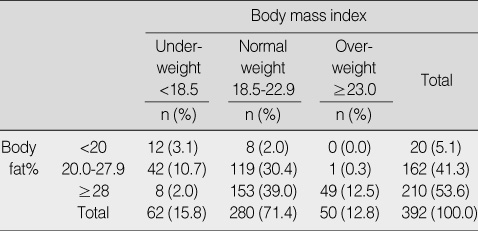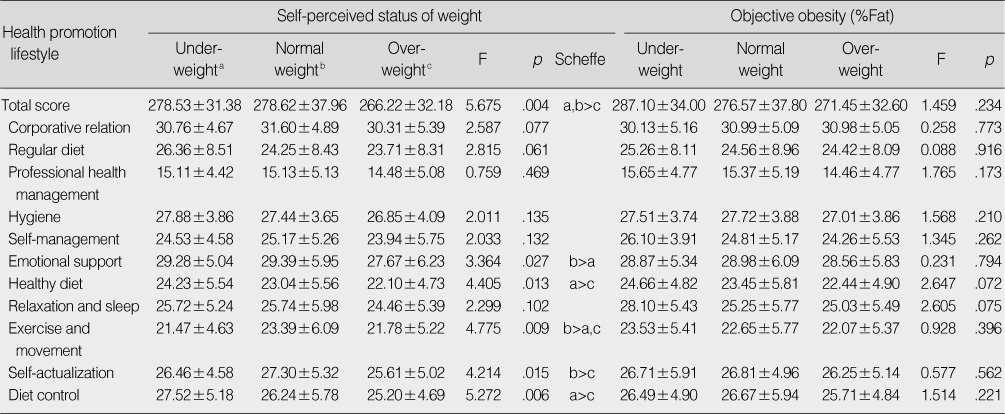Articles
- Page Path
- HOME > J Korean Acad Nurs > Volume 39(5); 2009 > Article
-
Original Article
- Health Promotion Lifestyle According to Self-Perception of Obesity and Objective Status Measured by Bioelectric Impedance Analysis in College Women
-
Eun Young Chang, Jeong Sun Kim, Su Jin Shin

-
Journal of Korean Academy of Nursing 2009;39(5):693-699.
DOI: https://doi.org/10.4040/jkan.2009.39.5.693
Published online: October 31, 2009
1Research Professor, College of Medicine, Sungkyunkwan University, Suwon, Korea.
2Assistant Professor, College of Nursing, Chonam National University, Gwangju, Korea.
3Assistant Professor, Department of Nursing, Soon Chun Hyang University, Cheonan, Korea.
- Address reprint requests to: Shin, Su Jin. Department of Nursing, Soon Chun Hyang University, 366-1 Ssangyong-dong, Cheonan 330-090, Korea. Tel: 82-41-570-2491, Fax: 82-41-575-9347, ssj1119@sch.ac.kr
• Received: March 2, 2009 • Accepted: September 18, 2009
Copyright © 2009 Korean Society of Nursing Science
Abstract
-
Purpose
- The purpose of this study was to identify congruence between self-perception and objective status of obesity according to %Fat, and to investigate health promotion lifestyle in college women.
-
Methods
- The participants were a convenience sample of 392 college women who were eligible and agreed to participate in this study. Respondents were asked questions using a health promotion lifestyle profile and were evaluated for their body composition using InBody 3.0. The data were analyzed with SPSS 14.0 program, which was used for Chi square, ANOVA, and post-hoc comparison with Scheffe.
-
Results
- The major findings were as follows; 1) Overall, 41.8% of participants misclassified their perceived status of weight by %Fat standards and kappa was 0.329. 2) Two percent were underweight by BMI but overweight by %Fat and 39.0% normal weight by BMI but overweight by %Fat. 3) There were significant differences in health promotion lifestyle according to self-perception of body weight but there was no difference in health promotion lifestyle according to %Fat standards.
-
Conclusion
- These findings suggest the necessity for development and application of tailored health promotion program based on self-perception of body weight and %Fat in order to reform incorrect body image and health behavior in college women.
- 1. Ajzen I, Madden TJ. Prediction of goal directed behavior, attitude, intentions and perceived behavioral control. Journal of Experimental Social Psychology. 1986;22:453–474.Article
- 2. American College of Sports Medicine. Korean College of Sports Medicine. ACSM's Resource Manual for Guidelines for Exercise Testing and Prescription. 2008;7th ed. Philadelphia, PA, Lippincott Williams & Wilkins Inc. (Original work published 2006).
- 3. Bas M, Kiziltan G. Relations among weight control behaviors and eating attitudes, social physique anxiety, and fruit and vegetable consumption in Turkish adolescents. Adolescence. 2007;42(165):167–178.PubMed
- 4. Cha ES, Park MY, Kim G. A comparison analysis of somatotype, physical activity, mental health, healthy behavior between normal weight and overweight college students in Korea. Korean Journal of Health Promotion and Diseases Prevention. 2008;8:245–255.
- 5. Cha KJ. Effect of an obesity management program on body weight, body mass index and physiological index of high schoolgirl students. Journal of Korean Academy of Nursing. 2004;34:1362–1371.ArticlePubMedPDF
- 6. Chang VW, Christakis NA. Self-perception of weight appropriateness in the United States. American Journal of Preventive Medicine. 2003;24:332–339.ArticlePubMed
- 7. Cheung PC, Ip PL, Lam S, Bibby H. A study on body weight perception and weight control behaviours among adolescents in Hong Kong. Hong Kong Medical Journal. 2007;13:16–21.PubMed
- 8. Faul F, Erdfelder E, Lang AG, Buchner A. G*Power 3: A flexible statistical power analysis program for the social, behavioral, and biomedical sciences. Behavior Research Methods. 2007;39:175–191.ArticlePubMedPDF
- 9. Jang YA, Chung HR, Lee HJ. Change of perception after weight management education among some elementary, middle and high school students in Seoul. Journal of The Korean Dietetic Association. 2002;8:269–279.
- 10. Jung DJ. Influence of weight control behavior, body image, self-esteem, health promotion behavior and mental health promotion behavior in university female students by BMI. Exercise Science. 2006;15:365–376.
- 11. Kim EM. Diet and nutrition problem in women. Journal of Korean Society for the Study of Obesity. 2002;11:257–262.
- 12. Kim H, Park JS. The effect of an exercise program on body composition and physical fitness in obese female and college students. Journal of Korean Academy of Nursing. 2006;36:5–14.PubMed
- 13. Kim HS. Correlations between waist-hip ratio, body fat, BMI (Body mass index), relative body weight and serum lipids by men and women. Journal of Korean Academy of Nursing. 1999;29:596–604.ArticlePDF
- 14. Kim HS. A study on the university students' obesity status and acknowledgement. Korean Sports Research. 2003;14:1417–1434.
- 15. Kim KH, Kim OR, Chung KO, Jeong KS, Lee EJ. Weight control experience, body image and stress coping according to obesity in college female student. 2004;Gimcheon, Kimcheon Science College.
- 16. Kim MH, Kim TW, Hong YJ, Son BK, Pai SH, Chang KJ, et al. The prevalence of obesity and underweight in adolescents in Incheon area and the relationship between serum cholesterol level and obesity. Journal of the Korean Pediatric Association. 2002;45:174–182.
- 17. Kim O. BMI, Body attitude and dieting among college women. Journal of Korean Academy of Adult Nursing. 2002;14:256–264.
- 18. Ko SK. The effect of BMI and %Fat as an obesity index on the diagnosis of hyperlipidemia in adult men. Exercise Science: Official Journal of the Korea Exercise Science Academy. 2005;14:21–30.
- 19. Korea Centers for Disease Control and Prevention. Health Behavior and Chronic Disease Statistics. 2006;Seoul, Author/Division of Chronic Disease Surveillance.
- 20. Korea National Statistics Office. Social Indicator in Korea. 2007;Daejeon, Author.
- 21. Korean Society for the Study of Obesity. Clinical Study of Obesity. 2001;2nd ed. Seoul, Korea Medical Book Publisher.
- 22. Lim IS. Sociocultural context of diet focused on college women's look-discriminatory experience and the body images of mass media. The Korean Journal of Sociology. 2004;38:165–187.
- 23. National Institute of Health. NIH Publication No. 02-5215. Detection, evaluation, and treatment of high blood cholesterol in adults. 2002;Bethesda, MD, Author.
- 24. Park IS. A study of the health promoting lifestyle. 1995;Busan, Pusan National University. Unpublished doctoral dissertation.
- 25. Park YW. 25% of elementary students are 'Normal body weight but high fat composition'. 2002;09 10 Retrieved February 20, 2009. from http://www.hani.co.kr/section-005100031/2002/09/00510003120020901854500.html.
- 26. Obesity and overweight. World Health Organization. 2009;09;Retrieved February 20, 2009. from http://www.who.int/mediacentre/factsheets/fs311/en/index.html.
REFERENCES
Figure & Data
REFERENCES
Citations
Citations to this article as recorded by 

- Association between obesity type and dyslipidemia by age and sex: a cross-sectional study using data from the 2022 Korea National Health and Nutrition Examination Survey
Eun-Hye Lee, Yun-Hee Kim
Journal of Korean Biological Nursing Science.2025; 27(2): 169. CrossRef - A secondary analysis examining the concordance of self-perception of weight and actual measurement of body fat percentage: The CRONICAS Cohort Study
Anthony L. Bui, Miguel G. Moscoso, Antonio Bernabe-Ortiz, William Checkley, Robert H. Gilman, Liam Smeeth, J. Jaime Miranda
BMC Obesity.2019;[Epub] CrossRef - Comparison of Health Promoting Lifestyle and Self-Efficacy in Female Students with and Without Primary Dysmenorrhea
Somayyeh Naghizadeh, Maryam Ebrahimpour maleki, Golsa Patras, Maryam Jafari
ranian Journal of Health Education and Health Promotion.2019; 7(3): 285. CrossRef - Body Weight Control Behavior and Obesity Stress of College Women
Yang-Hee Kang, Kyung-Hee Kim
The Journal of the Korea Contents Association.2015; 15(2): 292. CrossRef - Associations between Weight Control Behavior and Health Behaviors in Korean Young Women: 2013 Community Health Survey
Jae-Hee Kim
Journal of the Korea Academia-Industrial cooperation Society.2015; 16(7): 4734. CrossRef - Development of Health Dieting Competency Scale for College Students
Jeongsoo Kim, Yumi Lee
Korean Journal of Adult Nursing.2014; 26(3): 300. CrossRef - Health Promotion Behavior according to Body Mass Index and Self-Perception of Body Weight in Female Nursing Students
Su Jeung Yu, Kyung-Sook Lee, Joo Hyun Kim, Kyung Choon Lim, Jin Sook Park
Journal of Korean Biological Nursing Science.2014; 16(1): 60. CrossRef - Experiences of Health Related Lifestyles in High Body Fat but Non-obese Female College Students in Korea
Jeongsoo Kim
Osong Public Health and Research Perspectives.2014; 5(1): 68. CrossRef - Effect of Body Composition and Osteoporosis Self-efficacy on Bone Mineral Density of Female Nursing Students
Kyu Eun Lee, Nam Sun Kim
Journal of Korean Academy of Fundamentals of Nursing.2013; 20(3): 230. CrossRef - Body Composition, Blood Pressure, Blood Lipids, and Glucose according to Obesity Degree by Body Fat Percentage in Female University Students
Eun Hee Jang, Young Rye Park
Journal of Korean Biological Nursing Science.2012; 14(4): 231. CrossRef - Self-reported Realities of Health Behavior of Undergraduate Students After Web-based Health Promotion Education: Qualitative Content Analysis
Joo Hyun Kim, Eun Young Park, Kyung Choon Lim
The Journal of Korean Academic Society of Nursing Education.2012; 18(3): 413. CrossRef - The Process of Female University Students' Experiences in Healthy Dieting
Jeong-Soo Kim
Journal of Korean Academy of Community Health Nursing.2012; 23(3): 244. CrossRef - A Study of Body Composition, Dietary Behavior, and Exercise among Students at Women's Colleges
Ji-Yon Eom, Duk-Yoo Jung
Journal of Korean Public Health Nursing.2012; 26(1): 28. CrossRef - Weight control behavior in women college students and factors influencing behavior
Hyun-Young Yang, Young-Soon Byeon
Journal of Korean Academy of Fundamentals of Nursing.2012; 19(2): 190. CrossRef - Bone Mineral Density, Body Mass Index, Stress, and Health Promotion Lifestyle of Female College Students
Chunmi Kim, Eun Man Kim
Journal of Korean Academy of Community Health Nursing.2010; 21(3): 333. CrossRef
Health Promotion Lifestyle According to Self-Perception of Obesity and Objective Status Measured by Bioelectric Impedance Analysis in College Women
Health Promotion Lifestyle According to Self-Perception of Obesity and Objective Status Measured by Bioelectric Impedance Analysis in College Women
General Characteristics of Participants (N=392)
Comparison of Self-perceived Status of Weight with Objective Status
kappa=0.329.
Comparison of Body Mass Index with Body Fat
kappa=0.139.
Health Promotion Lifestyle by Self-perceived Status of Weight and Objective Obesity
Table 1
General Characteristics of Participants (N=392)
Table 2
Comparison of Self-perceived Status of Weight with Objective Status
Table 3
Comparison of Body Mass Index with Body Fat
Table 4
Health Promotion Lifestyle by Self-perceived Status of Weight and Objective Obesity
 KSNS
KSNS
 E-SUBMISSION
E-SUBMISSION




 Cite
Cite

